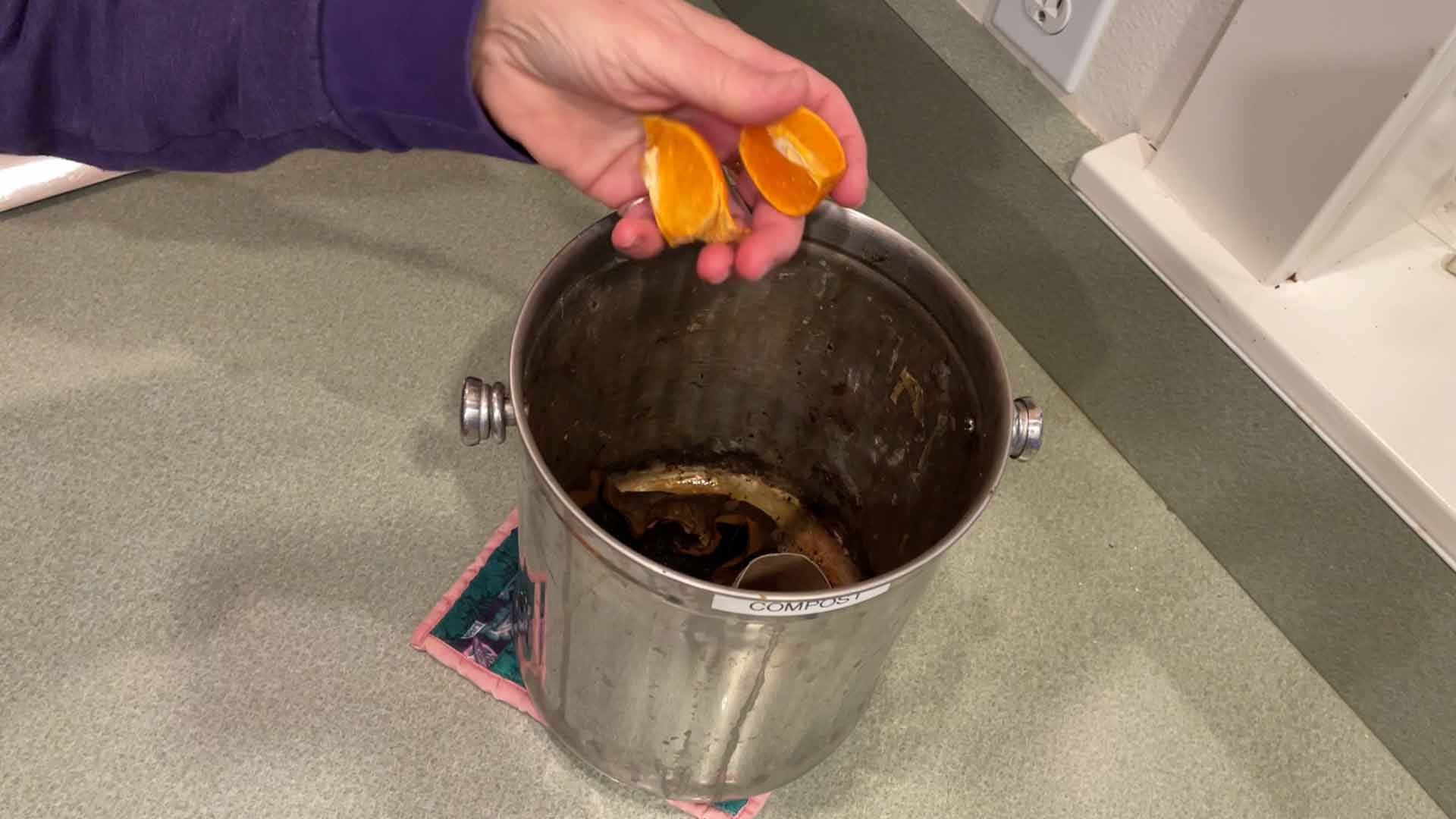How to Compost Food Waste in the Winter
I share my Top Two techniques for dealing with food scraps in the winter so you can keep them out of the landfill and put them to good use in your compost pile and your garden for year round nutrition for your plants.
Can you really compost in the winter?
Yes! In fact, these tips are easy to implement and they're the same ones I've used for 35 years.
You see, my goal for writing these articles and creating YouTube videos is to help you grow your dream garden using super-easy organic gardening techniques.
So in the article, you'll learn how to re-purpose your kitchen scraps without ending up with a stinky mess using the exact same methods that I use all year 'round. So let's get started!
Get the FREE Guide: Composting for Beginners
Features the 4 proven steps to get finished compost in 6 weeks! Click HERE to download your copy.

How to Start Saving Kitchen Scraps for Compost
Food scraps are a RESOURCE!
So if you're in any way a cook, then you know the frustration when the weather turns cold and it's not so easy to deal with food scraps or make compost.
Do you stop cooking?
No... Absolutely NOT!
So I've lived in Alaska for almost 40 years now, and I've spent a good amount of that time experimenting and field testing tons of composting and organic gardening techniques.
So here, I'm going to share with you my favorite top two techniques for dealing with this fabulous resource called "food scraps" to prevent organic material filling up your community landfill, and give you options so you can take what you learn here and decide which methods work best for your specific situation.
DID YOU KNOW?
According to the United Nations:
- Globally, around 14 percent of food produced is lost between harvest and retail. Significant quantities are also wasted in retail and at the consumption level.
- Food that is lost and wasted accounts for 38 percent of total energy usage in the global food system.

The Collection Container
How to set up your kitchen for success
I want you to be successful, so let's start by setting yourself up for consistent success.
Start by dedicating a "collection container" in your kitchen. It can be a bucket, a yogurt tub, or a reusable bag. This is where you'll toss in food scraps and other compostables.
Keep it handy so you're not tempted to get lazy and throw away perfectly good stuff.
Yes, perfectly good stuff.
Food scraps are NOT garbage. Read my lips. Egg shells and eggplant, coffee grounds and corn cobs, these are resources and they don't belong in the landfill where they simply rot and create harmful gases.
The sooner we change our attitude and our actions around what is garbage, the better off we'll be and the faster our planet can heal.
All right, back to the collection bucket.
When the bucket is full, head outside where you'll have two basic options to choose from.
- The garden
- The "Compost Closet"
I'll cover both of these now. By the way, to get the "Full Monty" of this article, check out my video below...
WHAT GETS WRITTEN, GETS REMEMBERED
Write this down: Dry soil... is warm soil... is workable soil.
#1: The Garden for Composting Food Waste...
Walk out to your garden, and on the way, pick up a shovel because you're going to dig a hole. That's right. You're going to bury the food scraps in your garden.
Now, you might be thinking,
"But Marion, it's winter and the ground is frozen."
We can fix that...
First, write this down in your garden journal:
Dry soil... is warm soil... is workable soil.
Raised beds (see photo below) that are covered act like mini greenhouses. In the winter, they often protect seedlings of spinach, kale, arugula, and other greens that I sow in the previous September.
To set up the mini-greenhouses, I bend and secure PVC pipe sections into the raised bed and then cover the whole thing with reinforced plastic.
I am excited because we won't have to wait for a sunny day in May. We'll be eating fresh salads in March, maybe late February.
You can see more about raised beds in my YouTube video: How to Transform Your Raised Beds.

Why You Want to Cover Raised Beds in Winter
For raised beds that are NOT covered over the winter, it's a different story. The soil is as hard as a rock because it has been exposed to heavy rain, snow, sleet... and then it has frozen solid.
But as you can see in the photo above, the ground is NOT frozen! In fact, spinach is lush and healthy -- even in an Alaska. In this video, How to Grow Spinach from Seed, I talk about how to grow spinach over the winter and when to sow seed in the fall.
And so, where you have fluffy soil is where you want to practice what I call "Dig and Drop" with your food scraps.
Dig and Drop is easy:
- Dig a hole about 12 inches deep
- Drop in food waste
- Cover with soil
- Done
#2: The "Compost Closet" for Composting Kitchen Scraps
Your Compost Closet serves as a storage place for food scraps until you can get an active, hot compost pile going.
Many receptacles will work as a compost closet:
- 5-gallon buckets
- Compost tumbler
- Tote
- Empty compost bin
To avoid a sloppy, stinky mess -- and these are important to remember -- when you dump in the food scraps be sure to alternate the food scraps with dry carbon material.

My favorite dry carbon material is leaves that we collect from the previous fall. We store them in bags under the deck and keep a container of them close to our composting area.
Finally, set up your compost closet where it's convenient (not out of sight, out of mind!), and keep it covered.
From the video, you'll see how one time, I needed to make room for a compost closet, so I emptied a compost bin (we have a 3-bin system) into 5-gallon buckets and then store the compost inside our hoop house (high tunnel).
Here are some timestamps to help you navigate through the video topics:
- 00:00 Welcome and intro
- 00:10 When the weather turns cold
- 01:30 Food scraps as a resource!
- 02:30 The "collection container "in the kitchen
- 03:50 The 2 ways to deal with food scraps
- 04:50 Benefits of covered raised beds
- 06:10 Tip #1: Dig-and-Drop composting
- 06:39 Tip #2: The "Compost Closet"
- 07:00 How to avoid a stinky mess
- 07:15 The benefits of leaves
- 08:20 Options if your garden is frozen
- 08:40 Tour of our compost setup
- 09:50 My experiment with winter composting
Then, I simply tossed the food scraps into the freed-up bin, add the leaves, and gave it a good stir each time. We were able to do this all winter without everything freezing into a solid block.
Thus, what goes in the compost closet freezes and thaws over the winter. Come spring, you just incorporate it into a new batch of compost!

And finally...
Collecting food scraps and putting them to use, whether you bury them or save them in a compost closet is something you can do year round.
One quick note, if you don't have a place outside just yet, or your garden beds are frozen, never fear. You have options:
- You can freeze them in plastic bags or containers in the freezer
- You can add them to a worm composting setup
- Donate them to a friend's compost pile
- Donate to your community collection site
When it comes to gardening and life, there are always options!
Enjoy this article? You might also enjoy these:
Who is Marion Owen?
Learn the fine art of nurturing your dream garden using organic methods that have been fine-tuned over 35 years by Marion Owen, New York Times bestselling author.
Gardening techniques that have been proven to work by Marion's students longing for their own dream garden in landscapes as diverse as North America, India, Europe, UK and Australia.
Finally, you can throw away all those harsh chemicals, as Marion only teaches methods that are in tune with Mother Nature!
Marion Owen's approach to fulfilling your dream garden will save you hundreds of dollar. At the same time bring natural vitality to you, your family and the planet.
Start to grow flowers, herbs and vegetables using a methodology in harmony with the natural environment.

